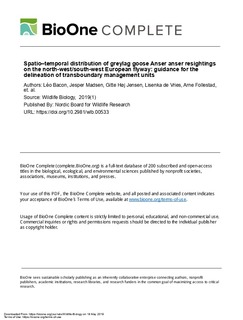Spatio–temporal distribution of greylag goose Anser anser resightings on the north-west/south-west European flyway: guidance for the delineation of transboundary management units
Bacon, Léo; Madsen, Jesper; Jensen, Gitte Høj; de Vries, Lisenka; Follestad, Arne; Koffijberg, Kees; Kruckenberg, Helmut; Loonen, Maarten; Månsson, Johan; Nilsson, Leif; Voslamber, Berend; Guillemain, Matthieu
Journal article, Peer reviewed
Published version

Åpne
Permanent lenke
http://hdl.handle.net/11250/2603550Utgivelsesdato
2019Metadata
Vis full innførselSamlinger
- Publikasjoner fra CRIStin - NINA [2364]
- Scientific publications [1392]
Originalversjon
10.2981/wlb.00533Sammendrag
In western Europe, the majority of wild goose populations have increased exponentially over the last decades. Such increase is the source of many socio–ecological conflicts. The need for coordinated management actions to handle the goose-related conflicts at the European scale has led to the establishment of a specific European Goose Management Platform (EGMP) under the auspices of the Agreement on the Conservation of African–Eurasian Migratory Waterbirds (AEWA). The northwest/ south-west (NW/SW) European population of greylag goose Anser anser has been considered as a priority concern, and an AEWA international single species management plan has been recently adopted. Because of the complex structure of the greylag goose population (e.g. spatial differences in migration strategies), and management (e.g. different hunting schemes among the range states), delineation of management units (MUs) based on goose movement characteristics was deemed necessary to further implement effective management actions. Based on neckband marking in various breeding regions and subsequent resighting locations, we conducted spatio–temporal analysis based on kernel methods to infer spatio–temporal and migratory movements of greylag geese in the NW/SW European flyway. The results highlight the existence of contrasted migratory behaviour, dispersal patterns and phenology within the flyway. From these results three international management units could be delineated. The first MU would include migratory birds from Norway. Birds from breeding grounds in Sweden and Denmark would represent the second MU. Finally, a third central MU was delineated, including primarily breeding birds from the Netherlands and northwestern Germany, which do not show migratory behaviour at the flyway scale. The delineation of these MUs has to be considered within an adaptive process, and future studies will enable a refinement of the definition of such units in order to continuously improve the efficiency of management plans. adaptive management, kernel, migration, neckbanding, waterbirds
